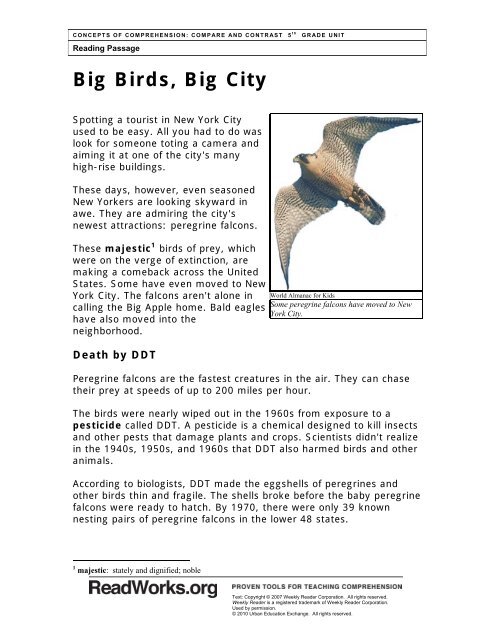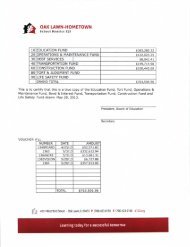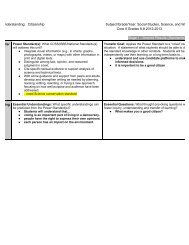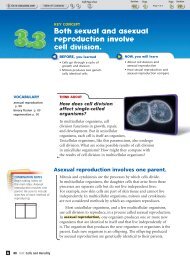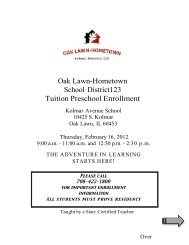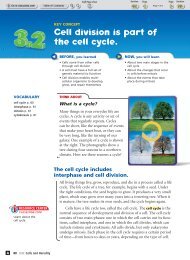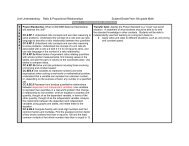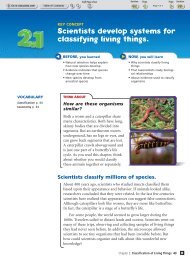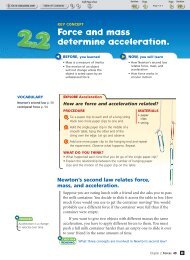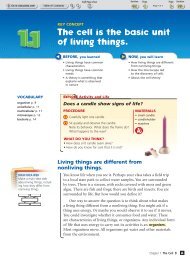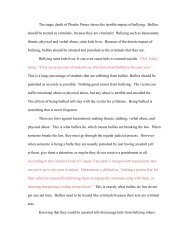Big Birds, Big City
Big Birds, Big City
Big Birds, Big City
Create successful ePaper yourself
Turn your PDF publications into a flip-book with our unique Google optimized e-Paper software.
CONCEPTS OF COMPREHENSION: COMPARE AND CONTRAST 5 th<br />
Reading Passage<br />
GRADE UNIT<br />
<strong>Big</strong> <strong>Birds</strong>, <strong>Big</strong> <strong>City</strong><br />
Spotting a tourist in New York <strong>City</strong><br />
used to be easy. All you had to do was<br />
look for someone toting a camera and<br />
aiming it at one of the city's many<br />
high-rise buildings.<br />
These days, however, even seasoned<br />
New Yorkers are looking skyward in<br />
awe. They are admiring the city's<br />
newest attractions: peregrine falcons.<br />
These majestic 1 birds of prey, which<br />
were on the verge of extinction, are<br />
making a comeback across the United<br />
States. Some have even moved to New<br />
York <strong>City</strong>. The falcons aren't alone in<br />
calling the <strong>Big</strong> Apple home. Bald eagles<br />
have also moved into the<br />
neighborhood.<br />
Death by DDT<br />
World Almanac for Kids<br />
Some peregrine falcons have moved to New<br />
York <strong>City</strong>.<br />
Peregrine falcons are the fastest creatures in the air. They can chase<br />
their prey at speeds of up to 200 miles per hour.<br />
The birds were nearly wiped out in the 1960s from exposure to a<br />
pesticide called DDT. A pesticide is a chemical designed to kill insects<br />
and other pests that damage plants and crops. Scientists didn't realize<br />
in the 1940s, 1950s, and 1960s that DDT also harmed birds and other<br />
animals.<br />
According to biologists, DDT made the eggshells of peregrines and<br />
other birds thin and fragile. The shells broke before the baby peregrine<br />
falcons were ready to hatch. By 1970, there were only 39 known<br />
nesting pairs of peregrine falcons in the lower 48 states.<br />
1 majestic: stately and dignified; noble<br />
Text: Copyright © 2007 Weekly Reader Corporation. All rights reserved.<br />
Weekly Reader is a registered trademark of Weekly Reader Corporation.<br />
Used by permission.<br />
© 2010 Urban Education Exchange. All rights reserved.
CONCEPTS OF COMPREHENSION: COMPARE AND CONTRAST 5 th<br />
Reading Passage<br />
GRADE UNIT<br />
Road to Recovery<br />
The U.S. government banned DDT in 1972. A year later, Congress<br />
passed the federal Endangered Species Act. The law protected many<br />
animals that were in danger of dying out, including peregrine falcons.<br />
Today, about 2,000 pairs of falcons nest nationwide, including 16<br />
couples in New York <strong>City</strong>. The first two falcon pairs moved to the city<br />
in 1983.<br />
Peregrine falcons usually nest on high cliffs. In and around Manhattan,<br />
though, the birds have built nests on bridge girders, church steeples,<br />
and tall buildings. Peregrine falcons seem to like New York <strong>City</strong>,<br />
according to biologist Chris Nadareski. There are plenty of pigeons and<br />
other birds to dine on. Plus, the bridges and skyscrapers provide high,<br />
open perches, similar to the perches on cliffs. Bird-watchers and<br />
bridge workers monitor the falcons with Web cameras.<br />
Last year [2005], a 10-week-old peregrine falcon left its nest too soon<br />
and crash-landed on a street beneath the Brooklyn Bridge. A falconer<br />
gave the dazed bird a clean bill of health and released it.<br />
Eagle Eye<br />
Bald eagles are the newest immigrants to<br />
New York <strong>City</strong>. In the early 1700s, the birds<br />
were a common sight in and around New<br />
York. But egg collectors and pesticides almost<br />
destroyed the entire bald eagle population in<br />
the United States.<br />
Two years ago, biologists took two male and<br />
two female eaglets 2 from northern Wisconsin<br />
to Manhattan. The scientists built a platform<br />
for the birds in a tree in northern Manhattan<br />
near the Hudson and Harlem rivers. Biologists<br />
brought four more eagles to New York from<br />
U.S. Fish and Wildlife Service Wisconsin this year. All have been flying near<br />
Biologists moved four bald eagles the Hudson River in the Bronx.<br />
from Wisconsin to New York <strong>City</strong>.<br />
2 eaglets: baby eagles<br />
Text: Copyright © 2007 Weekly Reader Corporation. All rights reserved.<br />
Weekly Reader is a registered trademark of Weekly Reader Corporation.<br />
Used by permission.<br />
© 2010 Urban Education Exchange. All rights reserved.
CONCEPTS OF COMPREHENSION: COMPARE AND CONTRAST 5 th<br />
Reading Passage<br />
GRADE UNIT<br />
The goal of the reintroduction program is to encourage the birds to<br />
nest and breed in the region, once again making it their home. To<br />
keep watch over the birds, scientists fitted them with radio tracking<br />
devices.<br />
"We're bringing our nation's symbol back to New York," the city's<br />
parks and recreation commissioner, Adrian Benepe, told National<br />
Geographic Today.<br />
<strong>Birds</strong> of a Feather<br />
Falcon<br />
Length: 18 to 20<br />
inches<br />
Wingspan: 36 to 45<br />
inches<br />
Maximum weight:<br />
2 pounds, 11 ounces<br />
(Females are about<br />
one-third larger than<br />
males.)<br />
Food: other birds<br />
Life span: 10 to 12<br />
years<br />
Did you know?<br />
A falcon's eyesight is<br />
eight times more<br />
powerful than a<br />
human's eyesight.<br />
Bald Eagle<br />
Length: 3 feet<br />
Wingspan: 6 feet to 7<br />
feet<br />
Maximum weight:<br />
Females can weigh up<br />
to 14 pounds. Males<br />
can weigh up to 10<br />
pounds.<br />
Food: mostly fish, but<br />
sometimes snakes and<br />
small birds<br />
Life span: 30 years<br />
Did you know?<br />
The bald eagle can see<br />
more than a mile<br />
away.<br />
Critical Thinking<br />
Why is it important to keep species such as the peregrine falcon and<br />
the bald eagle from disappearing for good?<br />
Text: Copyright © 2007 Weekly Reader Corporation. All rights reserved.<br />
Weekly Reader is a registered trademark of Weekly Reader Corporation.<br />
Used by permission.<br />
© 2010 Urban Education Exchange. All rights reserved.


